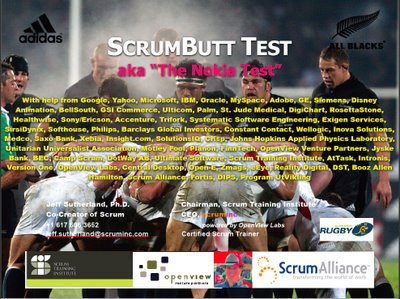ScrumButt Test: aka the Nokia Test

The "Nokia Test" for Scrum teams was developed orginally by Bas Vodde at Nokia Siemens Networks in Finland. It has been updated several times and appears in it latest incarnation in Jeff Sutherland's Scrum Certification classes where he demonstrates that attending the class yields an average return on investment of 1033% for participants.
Links to all previous versions of the Nokia Test, the current scoring of the ScrumButt test, and the 1033% ROI calculations can be found in the attached presentation, "The ScrumButt Test: aka The Nokia Test."
 Scrum is an Agile development framework that Jeff Sutherland invented at Easel Corporation in 1993. Jeff worked with Ken Schwaber to formalize Scrum at
Scrum is an Agile development framework that Jeff Sutherland invented at Easel Corporation in 1993. Jeff worked with Ken Schwaber to formalize Scrum at 

4 Comments:
Thomas, I appreciate your conservative nature. However, I am consistently doing this test in classes all over the world and participants (many who have been doing Scrum for some time) consistently say they can improve velocity 50% by increasing their ScrumButt test score from 4 to a 6. Many of them think they can do better than that.
The average U.S. team of 7 costs about $100,000 a month. In actual fact, a 50% increase in velocity will generate a lot more than $20000 more software revenue per month.
For example, if you read Benefield's paper on Yahoo, you will see that the financial office at Yahoo determined that a Scrum coach at Yahoo generated $1,000,000 in additional revenue per year by raising 10 teams production by 35%. This is about 1000% return on investment.
This was very conservative as she points out the teams that were well coached at Yahoo got 300-400% improvement. In our venture portfolio group we have companies that have increased their velocity 300% in three two week sprints immediately after attending my class.
Now, if the attendees at the class go back and do nothing they will get zero results, so maybe that is what you are seeing. People who go to the class and then don't change anything will produce ScrumButt implementations that suck. That has nothing to do with Scrum.
Jeff,
One of the things I have been meaning to ask you is about the "increased their velocity 300% in three two week sprints." I have seen this type of boost, but not simply from a ScrumMaster attending a 2-day class. With an integrated coach - yes.
A few people I have talked to who have attended your class walked away understanding they should resize stories at the end of the sprint they are completed in. Furthermore, they re-evaluate story sizes directly before the sprint they are planned for. We all know that stories always seem bigger later in the project.
My question is: "these teams with the 300% in three two week sprints immediately after attending my class" - did the story sizes remain constant and anchored prior to the first sprint? In not, and the story sizes are allowed to be fluid (aka, perpetually resized) then the result is story point inflation. It is a common phenomenon on projects to have the average story size increase the later in the project a story is sized. If story sizes are being inflated, the team's productivity is not increasing though Velocity appear to increase.
Giora Morein
Increase in velocity needs to be measured against stable reference stories. As noted in the Shock Therapy paper, when specific constraints on the Scrum team are enforced, a new team will consistently get a 200-300% velocity increase in three one week sprints. In London last week a new ScrumMaster achieved a 400% increase within a month of taking my class.
For most teams, an experienced Scrum coach is needed to get this effect because the new ScrumMaster cannot or will not enforce the necessary constraints.
Scrum is a simple framework with a set of constraints which if enforced with always result in a hyperproductive team. The fact that 90% of teams cannnot achieve this shows that most companies are so dysfunctional that they make it extremely difficult, so a powerful coach is needed as at MySpace.
It is easy to go hyperproductive. It is simple. And it is fast. The first Scrum did it in three sprints and anyone else can do the same if they simply execute the Scrum framework well.
Scrum is "hard" because we live in a land of mediocrity where dysfunction is OK. People have taken the blue pill and they are asleep. They will be put out of their misery whenever a Toyota shows up to take away their business.
Thanks, Jeff. See my questions at http://palfvin.blogspot.com/2009/10/nokia-test-questions.html
Post a Comment
<< Home